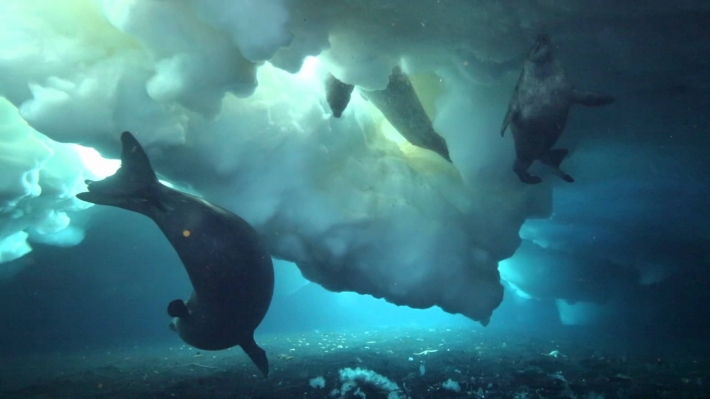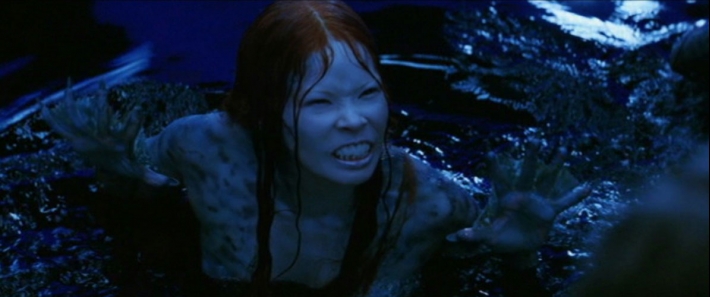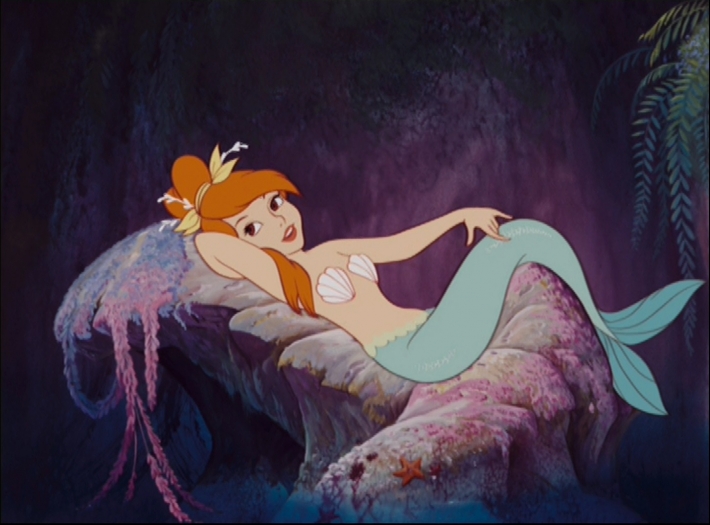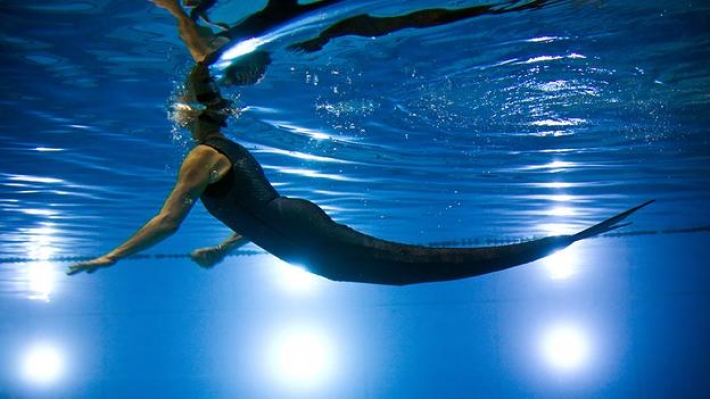This is Part II of an article covering the science of mermaids. In Part I, I noted the depiction of mermaids through history and identified some biological features of humans that would help a creature with the torso of a human and the tail of a fish to inhabit water, like the mermaids of fiction. Aquatic Ape theory suggests that humans may have had an aquatic period in their evolutionary past. The traits noted to support this theory would be of great benefit to a humanoid form living in an underwater environment. A close investigation of human biology could help us to understand a mermaid's appearance and biology, and how this would differ from a human's, if they were to exist.
The traits noted so far are those that make a humanoid form well adapted to swimming, though there are more pitfalls to be overcome in an underwater environment. As clothing would inhibit swimming, mermaids would have to be well-insulated against cold water and would need to be prepared for the pressures they would experience in water of depth. Humans retain an ability known as the 'Mammalian Dive Reflex' that helps humans combat the problems they face in a cold marine environment. Experiments conducted by Swedish born researcher, Per Scholander in the mid 20th century highlighted some interesting biological changes in deep-diving seals. He noticed that contact with water initiated a decrease in heart rate that allowed the seals to hold their breath for remarkable periods of time. To see whether humans exhibited the same reaction, he measured the heart rates of human volunteers as they dove to the bottom of a water tank. Immediately on contact with the water, a decrease in heart rate was detected. This remained low throughout the experiments. Even during vigorous underwater exercise, heart rates were much lower than on land. A lower heart rate results in the body using oxygen at a slower rate and so the volunteers were able to stay underwater for long periods of time.

Wedell seals crack holes in the ice to use as breathing holes.
In addition, Per Scholander noticed that blood began flooding away from the limbs and towards the volunteers' vital organs. This is known as Peripheral Vasoconstriction and it ensures that the brain and heart are kept oxygenated for longer, decreasing the chances of fatal or damaging effects. This change in the distribution of blood also has another use, counteracting the effect of high pressure on organs in deep water. At these depths, blood cells penetrate the walls of the organs to counteract the pressure and help the organs remain intact. This results in an apparent violation of Boyle's Law.
Boyle's Law predicts the behaviour of gases at various pressures. The pressure at 100ft underwater would kill a human if experienced on land. However, research shows that, thanks to the 'Mammalian Dive Reflex', lungs do not shrink and collapse as would be expected at such depths of water. Pressure on the lungs reduces them to one third of their natural volume, but they are not damaged by this.
Reduction of lung volume underwater has another interesting affect, as it makes the body less buoyant, allowing the diver to remain underwater more easily or even to walk along the ocean floor. The 'Mammalian Dive Reflex' is easily triggered, it requires a person simply to submerge their face in water, with the sole condition that the water be colder than the surrounding air.

A Mermaid from the 2003 film 'Peter Pan'.
This sudden biological change on contact with water has a poetic beauty when compared with examples from literature and film. Tales of transformations in early myth often occur on contact with water, such as Atargatis' change when she throws herself into a pool in shame. The plot of 1984 film 'Splash', starring Daryl Hannah as a mermaid who assumes a human form on land, is centred around the mermaid's efforts to conceal her real identity. Whenever she comes into contact with water, she assumes her mermaid shape, including an unmistakable fish tail, so she must avoid getting wet. This biological change is so sudden and so great, and the development of the mermaid tail gives it an especially magical quality. The 'Mammalian Dive Reflex' is also sudden and enacts a great biological change, even though it is relatively invisible. It is not known exactly what triggers the reflex, so it can appear quite 'magical' in its own way.
So a humanoid form would be able to withstand the pressure exerted on them in water of depth, but would it be adequately suited to cold water? Aquatic Ape theory also notes how humans have a high proportion of subcutaneous fat, which is very insulating from cold water. The relative distribution of fat in men and women highlights an interesting fact. Women tend to store fat mainly as subcutaneous fat, just below the skin, and it is more evenly distributed across the whole body. Men tend to store visceral fat in the abdomen, which would make them more susceptible to the cold. It seems the female form would find it easier to stay warmer in cold water. It then seems coincidental that the majority of depictions of merpeople are female, the archetypal mermaid. However, I doubt that many writers and artists took the female suitability to life in cold water as a consideration when deciding the gender of their characters. I doubt this could become an accepted explanation for a depiction solely of female, barely-clothed mercharacters in contemporary fiction. Also, the suggestion that, for scientific accuracy, all merpeople should be coated in a decent layer of subcutaneous fat, could be met with some mixed reviews.

A Bajau Fisherman.
Credit: James Morgan
However, examples of exceptional human divers complicate this suggestion. The Bajau divers of South East Asia have especially wiry frames, though they spend long periods of time underwater hunting for fish by walking along the seabed. There is evidence that a lean physique is more efficient at using oxygen and is less buoyant, helping the divers to stay upon the seabed and remain poised to hunt. However, these divers spend a defined period of time in the water before returning to shore and benefit greatly from the reduced buoyancy. The mermaids as depicted in fiction are more likely to benefit from the insulating effects of subcutaneous fat as they would spend long periods of time in water or around the water's edge. They are also more likely to rely on their swimming technique to hunt, rather than relying on being able to walk along the seabed.
Particular adaptations are seen in the biology of deep-sea divers and these are traits that mermaids are likely to have. People who partake often in deep-sea diving have blood rich in haemoglobin, which can allow their blood to take up more oxygen in a single breath, like that of people living at high altitude. Life underwater would also require adjustments to the difference in the behaviour of light. The Bajau divers are able to see underwater due to changes in their eye muscles. Contracted pupils allow for water distortion and eye muscles can also change the lens shape to encourage light refraction. However, there are also problems associated with deep-sea divers who do not undergo formal training. Many of the Bajau divers experience eardrum ruptures at a young age, as they haven't learned to equalise the pressure in their eyes while diving. Mermaids would either be susceptible to this problem, or they may adapt some method of coping with the pressure on their years.

'We were only trying to drown her'.
Credit: Walt Disney Productions
The appearance of the mermaids in art and literature is mainly of beings of unusual beauty, with colourful fins, thick and shiny hair and clear skin. However, the reality of underwater living is likely to impact their appearance. They are likely to shed their hair, or have very thin, minimal hair, to allow for more streamlined movement through the water. Their skin may be of a colour that allows them to be better camouflaged in their marine environment, maybe green or grey to hide among underwater foliage. Harry Potter encounters mermaids in the Black Lake near Hogwarts in J K Rowling's fifth novel in that series, 'Harry Potter and the Goblet of Fire'. She notes how the underwater darkness would result in an appearance better suited to their environment than the beautiful depictions from mythology and literature:
Here and there at the dark windows, Harry saw faces...faces that bore no resemblance at all to the painting of the mermaid in the prefects’ bathroom... The merpeople had grayish skin and long, wild, dark green hair. Their eyes were yellow, as were their broken teeth, and they wore thick ropes of pebbles around their necks.
-- Rowling, 'Harry Potter and the Goblet of Fire'
One other children's tale in which mermaids are prominent is J M Barrie's 'Peter Pan'. The depictions of mermaids in the subsequent adaptations vary, but Barrie's original mermaids appear to be typically beautiful and vain, descriptions include them singing, combing their hair and playing with bubbles in the shallows. The Disney film adaptation (1953) depicts them similarly, with long flowing hair, reclining on the rocks in seashell bikinis. The 2003 film poses a more realistic take on mermaids. They are strangely alluring, but not traditionally beautiful, with slippery, fish-like bodies and webbed hands and feet.
The other prominent characteristic of mermaids, though not always included in their depictions, is a shimmering fish tail. Discussing the likely evolution of a fish tail on a human body is probably not very interesting, but if it did occur, there is plenty of evidence to show that it would be a beneficial adaptation to a marine humanoid. Some freedivers have taken up the alternative sport of 'Mermaiding', which involves freediving with a fish-like fin. These freedivers often dress up and behave like mermaids to complete the experience. Swimming with a monofin is not at all inhibitive, as the dolphin-like leg-kick is an easy and efficient method of propulsion through the water, though the covering fin may decrease the streamlined-ness of the swimmer.

Nadya Vessey swimming with her fin, designed by Weta Workshop.
Double-leg amputee, Nadya Vessey was born with a condition that prevented her legs from developing properly and so has had a lifelong inclination towards swimming. Weta Workshop, who coincidentally made the mermaid fins for the 2003 'Peter Pan' film, created a mermaid tail that would enhance her swimming experience and allow her to excel in the water. The tail is both functional and beautiful. It is designed so that water floods into the costume, preventing it from being too buoyant and floating on the surface. Vessey said she aimed to complete the swimming section of a triathlon with her new tail and she now has the opportunity to tell curious children, enquiring about her legs, that she is a mermaid.
Despite appearing as the fantastical creatures of mythology and literature, the Aquatic Ape Theory suggests that human evolution may have included a stage where we could have lived like mermaids. Whether or not this theory is based in truth, it is undeniable that humans have particular features that allow them to live more comfortably in water than other animals, and to adapt to immersion in water. Evolution and environmental need could drive us to developing these features further. However, a humanoid marine creature would not be entirely like the depictions in film, literature and mythology. Earlier depictions that do not include the mermaid tail are likely to be more realistic (at least until we've had the time to evolve a fish-like tail!), and the beautiful depictions of mermaids are in contradiction with the traits they would need to survive underwater.
References & Further Reading
- Barrie, 'Peter And Wendy', Hodder & Stoughton (1911).
- Rowling, 'Harry Potter And The Goblet Of Fire', Bloomsbury (2000).
- Nestor, 'Your Body's Amazing Reaction To Water', TED (2014).
- Schmidt-Nielsen, 'A Biographical Memoir, Per Scholander 1905-1980', National Academy Of Sciences (1987).
- 'Peter Pan', Walt Disney Productions (1953).
- 'Peter Pan', Columbia Pictures (2003).
- 'Splash', Touchstone Films (1984).
- 'Mermaids: The Body Found', Animal Planet (2012).
- Weta-workshop.
Listing image: Chris Crumley
